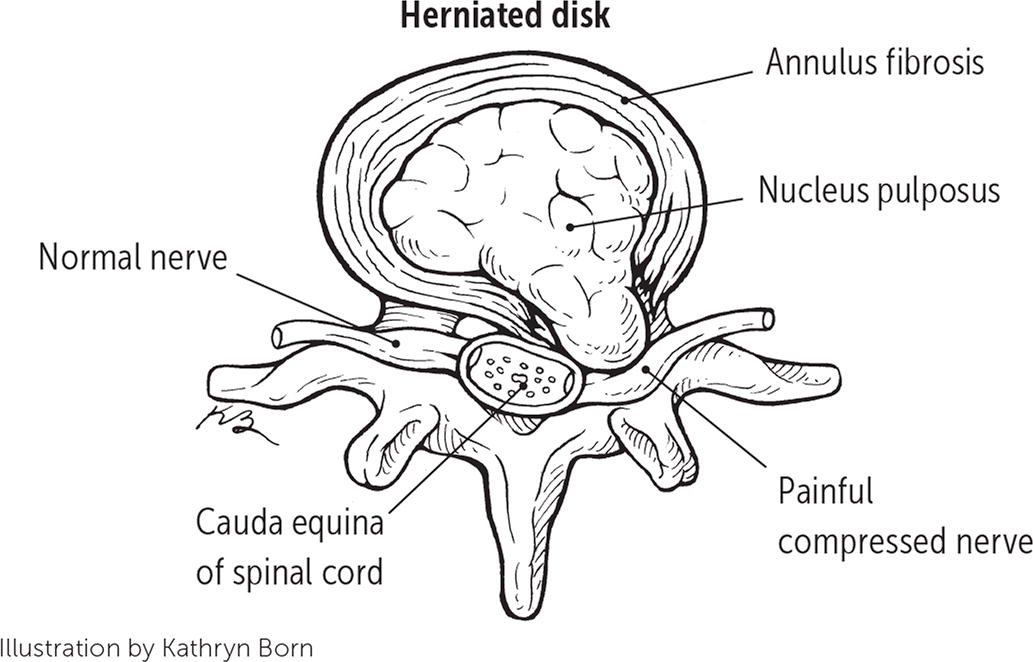
Am Fam Physician. 2018;98(7):online
See related article on mechanical low back pain
What is low back pain?
Low back pain is when you feel soreness or discomfort in your lower back, buttocks, or hips. It is a common problem.
What causes low back pain?
It is usually caused by muscle strain in your lower back. If you strain a muscle in your back, it can hurt to move it, walk, bend, or twist.
Another cause of low back pain is a bulging disk. Disks in your spine give cushioning and support. When a disk bulges, or herniates, it may irritate a nerve (see drawings). This can cause pain that goes down your thigh or leg. Pain caused by nerve irritation is called sciatica (sigh-AT-tic-ah).
Sometimes, back pain is caused by an infection, cancer, or other diseases. This is rare.
Who gets low back pain and why?
Three out of four people have low back pain at some time in their lives. You can get low back pain from straining to lift heavy objects or by twisting your back. People often hurt their backs when they are moving furniture, playing sports, or gardening. It can also happen while you are at work.


How long will it last?
Most people slowly start to feel better over a few weeks. Nearly all people are completely better within six to eight weeks.
How will my doctor find the cause of the pain?
Your doctor will ask you questions about your pain and will give you a physical examination.
Most people don't need to have an x-ray or other scans. Your doctor will decide if you should have these tests after your examination.
Will bed rest help?
You may need to rest in bed for a day or two, but too much bed rest can stop you from getting better. Some people worry that staying active will hurt their backs more. Getting back to your normal activities may hurt or be uncomfortable at first, but it shouldn't cause any damage. You may try gentle stretches or yoga before returning to your normal activities.
What can I do to help with the pain?
Try not to do things that make the pain worse, like sitting for a long time, lifting heavy objects, or bending or twisting.
Stick to your normal activities as much as you can. Gentle exercise like walking helps you get better faster.
Some over-the-counter medicines can help pain or swelling. These include ibuprofen (brand name: Advil or Motrin), naproxen (brand name: Aleve or Naprosyn), and acetaminophen (brand name: Tylenol). Your doctor may also prescribe medicine to help with pain or muscle spasms.
Try using heating pads or taking a warm bath or shower.
Your doctor can show you some gentle exercises to help stretch your back and make the muscles stronger.
A physical therapist, massage therapist, or chiropractor may help with your pain and make you feel better.
When should I return to work?
Your doctor can tell you when it is okay to go back to work. It is important to try to stay active. But, if you have to sit for many hours or do a lot of physical activity at work, you may need to make some changes for awhile.
How can I prevent low back pain?
You can prevent low back pain with physical therapy, exercising, and stretching. Supports and back belts do not prevent low back pain.
Exercise regularly and lose weight if you are overweight. Being inactive can lead to low back pain. Regular exercise like walking, swimming, or biking is good for your back. These activities put less stress on your back than sitting and standing.
Don't lift heavy objects by bending over at the waist. Bend your hips and knees and then squat to pick up the object. Keep your back straight and hold the object close to your body. Don't twist your body while you are lifting.
If you have to sit at your desk or drive for a long time, take breaks to stretch.
How can I tell if my back pain is serious?
You should get medical care right away if:
You are older than 50 years
The pain was caused by an injury, like a fall or car crash
You have trouble sleeping because of the pain
You lose weight without trying or have a fever, chills, or a history of cancer
You have trouble urinating or controlling your bowels
Tell your doctor if the pain goes down your leg below your knee, or if your leg, foot, or groin feels numb. See your doctor if your pain doesn't get better after two or three weeks of treatment.
Where can I find more information?
Your doctor
AAFP's Patient Information Resource
Backcare
National Library of Medicine MedlinePlus
Spine-health
